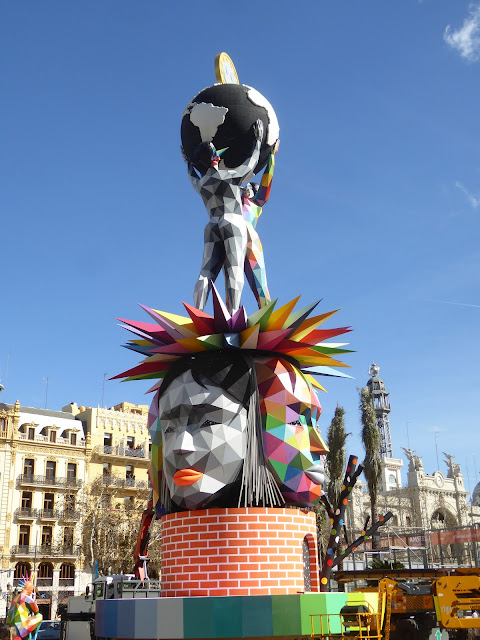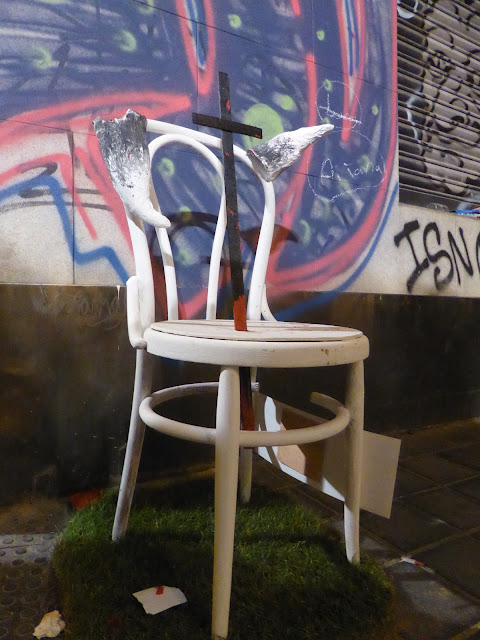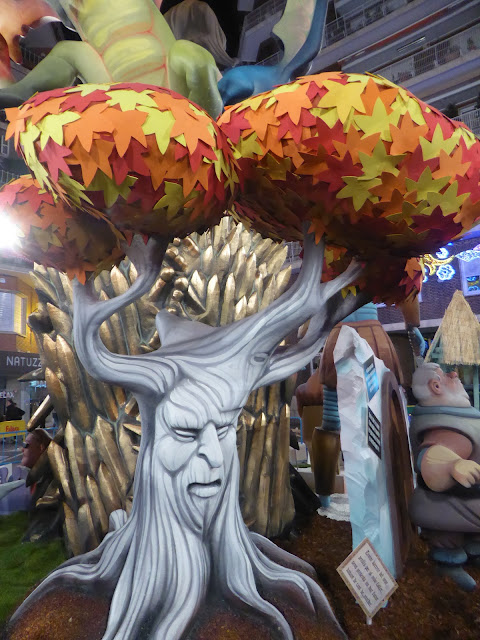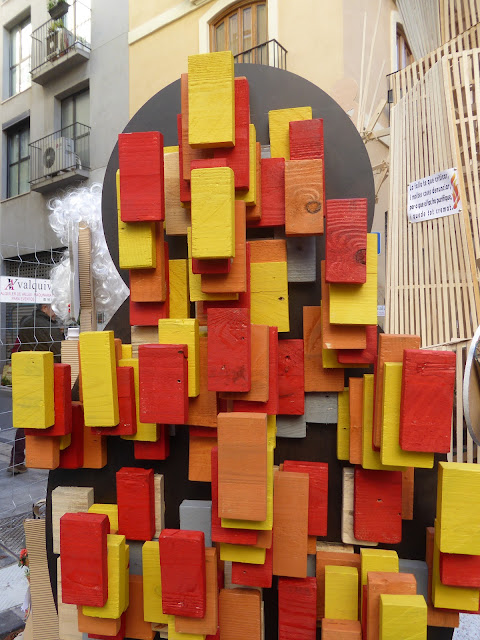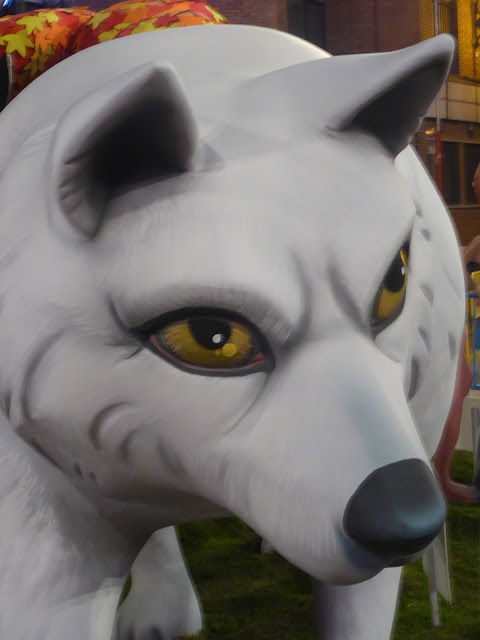This is my fourth Fallas de Valencia celebration. It is familiar enough now that there are no big surprises. What is perhaps different is the number of visitors to the city during the festivities this year. Valencia has a population of approximately 790,000 within the city limits, and anywhere from 1.5-1.6 million residents in the wider urban area. (Other statistics show 2.5 million depending on how the metropolitan area is defined). The city receives upwards of 2 million visitors per year.
Reports this year indicate that as many as 1 million people came into town for Falles. Two extenuating factors: last year, Falles was added to UNESCO's Representative List of the Intangible Cultural Heritage of Humanity. Second, this year March 15-19 (the unchanging dates of the festival) fell over a weekend, allowing masses of Spaniards to visit the city in addition to the normal hordes of tourists from further afield.
The above photograph, taken from a balcony of my piso, is of the crowd assembled for the thundering five-minute Plaza Ayuntamiento (town hall plaza) mascletà on March 3! And this corner is a block away from the plaza. The mascletà is a daily event for the month of March leading to Falles. When I say thundering, I mean window-rattling, ear-popping, gut- clenching sound, unlike anything you will ever hear outside of, I assume, a war zone.
This year, everything seemed louder than usual, the mascletà, the music, the fireworks, the childrens' firecrackers. (I saw one parent handing a 2-year old still in a stroller little cherry bombs to throw. Boy, did she cry when one failed to go off!) Just the noise of the crowds alone was thunderous. We are also talking about 24 hours per day. The biggest fireworks event started at 1:30 A.M. along the river bed that runs through the city.
It was great!
Another facet of the event: How to feed all of the visitors. Loads of food stalls and food trucks. I started photographing the interesting ones...and the people taking to the streets to eat.
All part of what is below: a random sample of the sights during this incredible community/national/and now, international event. Read about it and then take a look at the photos. And you are correct, there are no photos of the denouement of Falles, la crema - the burning of the falles. For that, you will need to look at the postings from the previous years.
Reports this year indicate that as many as 1 million people came into town for Falles. Two extenuating factors: last year, Falles was added to UNESCO's Representative List of the Intangible Cultural Heritage of Humanity. Second, this year March 15-19 (the unchanging dates of the festival) fell over a weekend, allowing masses of Spaniards to visit the city in addition to the normal hordes of tourists from further afield.
The above photograph, taken from a balcony of my piso, is of the crowd assembled for the thundering five-minute Plaza Ayuntamiento (town hall plaza) mascletà on March 3! And this corner is a block away from the plaza. The mascletà is a daily event for the month of March leading to Falles. When I say thundering, I mean window-rattling, ear-popping, gut- clenching sound, unlike anything you will ever hear outside of, I assume, a war zone.
This year, everything seemed louder than usual, the mascletà, the music, the fireworks, the childrens' firecrackers. (I saw one parent handing a 2-year old still in a stroller little cherry bombs to throw. Boy, did she cry when one failed to go off!) Just the noise of the crowds alone was thunderous. We are also talking about 24 hours per day. The biggest fireworks event started at 1:30 A.M. along the river bed that runs through the city.
It was great!
Another facet of the event: How to feed all of the visitors. Loads of food stalls and food trucks. I started photographing the interesting ones...and the people taking to the streets to eat.
All part of what is below: a random sample of the sights during this incredible community/national/and now, international event. Read about it and then take a look at the photos. And you are correct, there are no photos of the denouement of Falles, la crema - the burning of the falles. For that, you will need to look at the postings from the previous years.
(Edited from Wikipedia with personal observaitons added.)
Background
Background
Falles (Valencian) / Fallas (Spanish) - pronounced, "FI-es" / "FI-as" - is a traditional celebration held in commemoration of Saint Joseph in Valencia. The term Falles refers to both the celebration and the monuments created during the celebration. A number of towns in the Comunidad Valenciana have similar celebrations inspired by the original Falles de València celebration. Each neighborhood of the city has an organized group of people, the Casal faller, that works all year long holding fundraising parties and dinners, usually featuring the famous dish, paella, a specialty of the region. Each casal faller produces a construction known as a falles which is eventually burnt. A casal faller is also known as a comissió fallera.
History
There are different speculations regarding the origin of the Falles festival. One suggests that the Falles started in the Middle Ages, when artisans disposed of the broken artifacts and pieces of wood they saved during the winter by burning them to celebrate the spring equinox. Valencian carpenters used planks of wood called parots to hang their candles on during the winter, as these were needed to provide light to work by. With the coming of the spring, they were no longer necessary, so they were burned. Over time, and with the intervention of the Church, the date of the burning of these parots was made to coincide with the celebration of the festival of Saint Joseph, the patron saint of carpenters.
This tradition continued to evolve. The parot was dressed with clothing so that it looked like a person; features identifiable with some well-known person from the neighborhood were often added as well. To collect these materials, children went from house to house asking for una estoreta velleta (an old rug) to add to the parot. This became a popular song that the children sang as they gathered all sorts of old flammable furniture and utensils to burn in the bonfire with the parot. These parots were the first ninots. With time, people of the neighborhoods organized the building of the falles and the typically intricate constructions, including their various figures, were born.
Here, crews of artists and artisans, sculptors, painters, and many others all spend months producing elaborate constructions of paper and wax, wood and styrofoam tableaux towering up to five stories, composed of fanciful figures in outrageous poses arranged in gravity-defying architecture. Each of them is produced at the direction of one of the many individual neighbourhood Casals fallers who vie with each other to attract the best artists, and then to create the most outrageous monument to their target. There are more than 500 different falles in Valencia, including those of other towns in the Valencian Community.
Events
The timing of the events is fixed and they fall on the same dates every year, March 15-19.
La Despertà
Each day of Falles begins at 8:00 am with La Despertà ("the wake-up call"). Brass bands appear from the casals and begin to march down every street playing lively music. Close behind them are the fallers, throwing large firecrackers in the street as they go.
La Mascletà
The Mascletà, an explosive barrage of coordinated firecracker and fireworks displays, takes place in each neighbourhood at 2:00 pm every day of the festival; the main event is the municipal Mascletà in the Plaça de l'Ajuntament where the pyrotechnicians compete for the honor of providing the final Mascletà of the fiestas (on 19 March). At 2:00 pm the clock chimes and the Fallera Mayor (dressed in her fallera finery) will call from the balcony of City Hall, Senyor pirotècnic, pot començar la mascletà! ("Mr. Pyrotechnic, you may commence the Mascletà!"), and the Mascletà begins.
La Plantà
The day of the 15th all of the falles infantils are to be finished being constructed and later that night all of the falles majors (major Falles) are to be completed. If not, they face disqualification.
L'Ofrena de flors
In this event, the flower offering, each falla casal takes an offering of flowers to the Virgin Mary as Our Lady of the Abandoned. This occurs all day during 17–18 March (starting in the early afternoon and continuing almost to midnight). A statue of the Virgin Mary and its large pedestal are then covered with all the flowers.
Els Castells and La Nit del Foc
On the nights of the 15, 16, 17, and 18th there are firework displays in the old riverbed in Valencia. Each night is progressively grander and the last is called La Nit del Foc (the Night of Fire).
Cabalgata del Fuego
On the final evening of Falles, at 7pm on March 19, a parade known in Spanish as the Cabalgata del Fuego (the Fire Parade) takes place along Colon street (leading to) Porta de la Mar square. This spectacular celebration of fire, the symbol of the fiesta’s spirit, is the grand finale of Falles and a colourful, noisy event featuring exhibitions of the varied rites and displays from around the world which use fire; it incorporates floats, giant mechanisms, people in costumes, rockets, gunpowder, street performances and music. (Unclear if this event is still current. - it has been cancelled several times.)
La Cremà
On the final night of Falles, around midnight on March 19, all of the falles are burnt as huge bonfires. This is known as La Cremà (the Burning), the climax of the whole event, and the reason why the constructions are called falles ("torches"). Traditionally, the falle in the Plaça de l'Ajuntament (the town center) is burned last around 1:30 A.M. Many neighbourhoods have a falla infantil, a children's falla, smaller and without satirical themes, which is held a few metres away from the main one. This is burnt first, at 10:00 P.M.
(The rest are ostensibly burned around midnight. The fire department sends teams to each falle to supervise the burning and it is clear that they cannot be everywhere at once. In one barrio I visited a few years aglo, the falle was not ignited until around 2:30 A.M. A large contingent of the neighborhood residents, including their young children, waited patiently for the denouement.)
Each falle is laden with fireworks which are lit first. The construction itself is lit either after or during the explosion of these fireworks. Falles burn quite quickly, and the heat given off is felt by all around. The heat from the larger ones often drives the crowd back a couple of metres, even though they are already behind barriers that the fire brigade has set several metres from the construction. In narrower streets, the heat scorches the surrounding buildings, and the firemen douse the façades, window blinds, street signs, etc. with their hoses to stop them catching fire or melting, from the beginning of the cremà until it cools down.
Away from the falles, people frolic in the streets, the whole city resembling an open-air dance party, except that instead of music there is the incessant (and occasionally deafening) sound of people throwing fireworks around randomly. There are stalls selling products such as the typical fried snacks porres, xurros and bunyols, as well as roasted chestnuts or trinkets.
*******
On the "Day of Crida," the last Sunday in February, Valencia's mayor announces to an enormous waiting crowd, "ya estem en Falles." Translation from the Valencian: " We are now in Falles. Join in the festivities. Remember though, the falles you see here have already disappeared, gone up in smoke. The centuries-old tradition continues.


Les falles
Ninots, waiting patiently to be unwrapped and displayed.
At the Plaza Ayuntamiento (town hall plaza) by artist,
Okuda San Miguel
Los falleros
Los falleros
Las luces

La música
La comida

IIIIIIIIIIIIIIIIIIIIIIIIII
_____________________________________________
Copyright © 2015-2023 Benjamin Clavan








